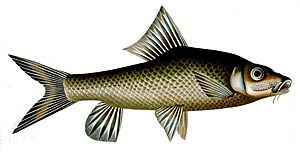Humpback mahseer facts for kids
Quick facts for kids Humpback mahseer |
|
|---|---|
 |
|
| Conservation status | |
| Scientific classification | |
| Synonyms | |
|
The humpback mahseer (Hypselobarbus mussullah) is a special type of ray-finned fish. It belongs to the carp and minnow family, known as Cyprinidae. This fish is found only in India and is part of the Hypselobarbus group.
Contents
What Does the Humpback Mahseer Look Like?
The humpback mahseer is a large fish. Its body is flattened on the sides. It has a noticeable hump on its back, which gives it its name. This hump goes from its head to its dorsal fin.
Mouth and Fins
This fish has a narrow mouth that points downwards. It also has thick lips. Around its mouth, it has two pairs of short whiskers, called barbels. These barbels help it find food. One pair is near its nose, and the other is near its jaw. These barbels help tell it apart from similar fish.
Its dorsal fin starts just before its pelvic fins. The top edge of the dorsal fin is curved inwards. It has a strong, smooth, and stiff spine. The tail fin, called the caudal fin, is deeply split. It has small bumps on its rays.
Size and Color
The humpback mahseer is usually brown on top. Its belly is a lighter color. Its fins might have dark tips. This fish can grow very big! It can reach up to 150 centimeters (about 5 feet) long. It can also weigh as much as 90 kilograms (about 200 pounds). The biggest one caught with a fishing rod weighed about 59 kg and was 169 cm long. Another one caught by other methods was 93 kg and 183 cm long.
How It Was Described
When this fish was first described in 1839, it was noted for a "remarkable projecting prominence" between its upper lip and nostrils. This made the fish look "Roman-nosed." Early descriptions also noted specific features like the number of rays in its fins. For example, it has 16 rays in its pectoral fin and 12 rays in its dorsal fin.
Where Does the Humpback Mahseer Live?
The humpback mahseer lives only in the Western Ghats of southern India. This area is a mountain range. It has been found in the Krishna River and possibly the Godavari River. These rivers are in the Indian states of Karnataka, Maharashtra, and Kerala.
Limited Living Space
The places where this fish lives are very spread out. They are like small, isolated pockets. The total area where this species lives is probably less than 500 square kilometers. This means their habitat is very fragmented.
What Is Its Habitat and Diet?
The humpback mahseer prefers to live in deep parts of clear, fast-flowing streams and rivers. These rivers are usually found in hilly or mountainous areas.
What It Eats
This fish is an omnivore, meaning it eats both plants and animals. Its diet includes other fish, small crabs and shrimp, snails, frogs, fruits, and algae.
Why Is the Humpback Mahseer Important to Protect?
The humpback mahseer has been a popular fish for anglers (people who fish with a rod and line) for a long time. This goes back to the British colonial era. However, for many years, people were not sure exactly which species of fish they were catching.
Clearing Up Confusion
The scientific description of this fish was not always clear. In the 1990s and again in 2016, scientists re-described the humpback mahseer. They officially placed it in the Hypselobarbus group. This helped clear up confusion with another fish, the orange-finned mahseer (Tor remadevii).
Distinguishing Species
When the humpback mahseer was thought to be part of the Tor group, it was sometimes confused with the orange-finned mahseer. The orange-finned mahseer is a highly endangered fish. It lives only in the Kaveri river basin. The humpback mahseer, however, lives in the Krishna river basin. When scientists realized these were two different species, they separated them. This was important for protecting both species correctly.


